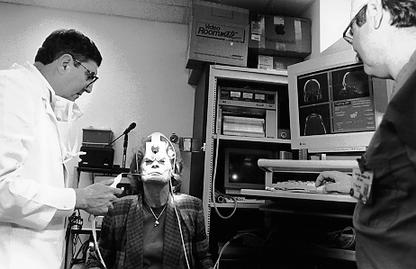
Dr. James Duncavage (left) demonstrates VUMC's new sinus imaging device on patient Eileen Petrelli as George Sprague, R.N., assists.
Device lets surgeons 'see' inside sinuses
A new imaging device that uses CT scans to help accurately map the movement of surgical instruments is enabling Vanderbilt University Medical Center surgeons to perform endoscopic sinus surgery procedures.
Dr. James A Duncavage, associate professor of Otolaryngology, leads the effort at VUMC and believes that the new imaging device will revolutionize sinus surgery.
"The use of intraoperative sinus imaging will become the standard of care," said Duncavage. "To me this technology is analogous to a pilot flying with instrumentation, instead of just visually."
VUMC is the only center in Tennessee and one of a handful of institutions in the country using the new technology, called the Insta Track system.
In normal procedures, the surgeon's knowledge of sinus anatomy is crucial, especially in revision sinus cases where landmarks within the sinuses can be distorted or absent. Revision sinus operations are usually done after previously unsuccessful sinus surgery and often involve alterations in the sinus anatomy.
Given the proximity to such delicate and intricate organs as the eyes and brain, any damage done when performing sinus surgery can be permanent and debilitating.
Until now surgeons have had to rely on the standard endoscope to guide them through the complicated passageways of the sinuses, a process not without its limitations, according to Duncavage.
"With the monocular endoscope you do not have binocular vision, so there is no depth perception. Also, you are always working in a small environment without a panoramic view, so it is hard to tell where you are," he said.
VUMC's new Insta Track system pinpoints the position of the tip of the endoscope ‹ the device used to probe the patients sinuses ‹ within 2 millimeters, then marks that position on a television monitor that displays the sagital, coronal, and axial planes.
The display is created earlier by a CT scanner which orients the scan of the sinus with a localizing device ‹ or halo ‹ that fits on the patient's head.
In its simplest terms, the CT scanner measures each anatomical region of the patient's sinuses in relation to the halo, so that, when refitted at the time of the surgery, the computerized map of the patient's sinuses is exactly the same as the actual anatomical structures that the surgeons are probing.
The halo is configured so that it fits into the ear canals and stretches across the forehead, ensuring that it will be in the exact same position when placed on the patient for surgery.
As the surgeon uses the endoscope to clear infected sinuses, the picture on the television screen moves to show where the probe is. This eliminates much of the guesswork involved in sinus surgery.
Obtaining this kind of precise imagery of a patient's sinuses will make sinus surgery safer while also reducing the trauma of surgery.
"What we previously had to do in some revision surgeries was to cut a hole into the frontal cavity to see where we were inside the person's head. The one thing you can't do is take a look with the endoscope when you don't know where you are and then back up if you make a mistake," said Duncavage.
The symptoms of sinus infections run the gamut from fatigue to asthma. It is estimated that 30 million Americans suffer from chronic sinusitis, and more then 300,000 of them undergo surgery each year to alleviate the condition.













